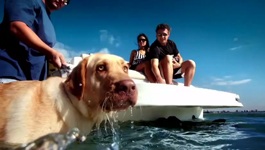Boating Lifestyle
Boating Lifestyle
There is so much to love, and learn, about boating. That's why we created this library of articles, videos and blog posts to help you throughout your adventures.
Traveling Toddlers: Keeping your Children Safe on a Boat

Boating with young children isn’t really all that different from putting them in the car and going out to the playground or swim park. You must have a process for preparing, traveling and enjoying your destination. You must use safety gear and take precautions. And you must be vigilant while still giving them their own space to operate and learn. The most important thing for you to have is a positive attitude.
- Before your child ever sets foot onboard you need to “childproof” it, just as you would if you were visiting the home of someone who is childless: basically, stow everything that’s breakable or dangerous. Winches, windlasses, ropes, gear boxes, ground tackle and other topside equipment should be out of reach, battened or otherwise secured. Make sure all safety gear, such as EPIRBS, flares, and flare guns, are up out of a child’s reach — but never locked away — just in case you need them. Areas where ropes and halyards are located should be off limits, since it’s easy to trip or to get a foot or hand wrapped up or caught.
- Investing in a good lifejacket or life vest with an age-appropriate design is a must. Look for one with a collar that turns the child face up in the water. Look for strong waist and crotch straps, and a handle on the collar. Is should have a plastic safety whistle and you should practice your toddler in its use. (Take the child with you when you buy the lifejacket; it will help with sizing and it will get them involved.) Always look for a label stating that the PFD has been approved by Transport Canada, the Canadian Coast Guard, Fisheries and Oceans Canada or any combination thereof before you purchase and make sure you understand the regulations and requirements of using PFDs. Also ensure you properly maintain whatever PFD or lifejacket you choose.
- That said, have a realistic approach to safety. They’re still the same kids you have at home, so expect the same behavior. Establish clear, enforceable rules and set boundaries for your kids. They need to be safe, but they also need to have a good time so that they will want to share boating with you in the future.
From here on out, making the trip enjoyable is just “Parenting 101.”
- Bring lots of fluids, particularly water and fruit juices. Remember baby bottles and/or sippy cups, and extras, just in case.
- Pack snacks that are not too salty or too sweet. Fruits and granola bars are great. Bring some not-too-salty crackers or, better yet, ginger snap cookies, which can help settle queasy stomachs. Ginger ale is good for this, too.
- Your diaper bag (or substitute a daypack) is a must. Pretty much you want to bring one extra of everything you’d normally carry: a full change of clothes, diapers, any lotions or creams, and wipes — bring plenty of those. They’re great onboard for everything, since freshwater is limited. Bring plastic bags to keep wet things away from dry things. Make sure you bring a hat, sunscreen and sunglasses, as well as a jacket in case it turns cool. You’ll probably also want to stash a rain poncho aboard.
- Remember that your young one may not be riveted by the waterfront mansions or sunset like you are. Bring crayons and drawing paper, and toys that can take the dampness. Bath toys are excellent choices, as are bathtub books, which fare better than paper books.


